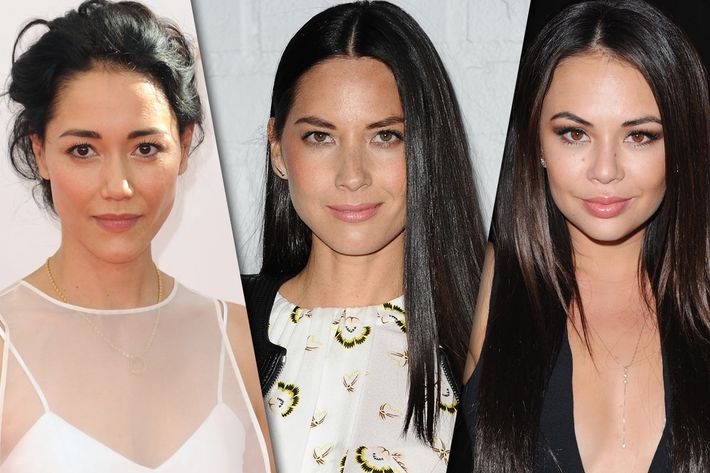
Over the weekend, I watched with a growing sense of dread as people on Facebook and Twitter debated whether or not people of mixed Asian descent could look like Emma Stone. One woman even posted photos of a child that she knew who had Asian ancestry, but still had blonde hair and light eyes. See? Just like Emma Stone. The occasion for all this phenotypic scrutiny was Cameron Crowe’s Aloha, in which his female protagonist, Allison Ng (“ing like ring,” she explains) is played by Emma Stone. Ng is hapa haole, a Hawaiian term meaning she’s of white and Hawaiian descent: Her father is half-Chinese, half-Hawaiian, and her mother is Swedish. “So I’m a quarter Hawaiian,” she says. This is a proud fact of her heritage that she announces a number of times, and a crucial one for the film. You will note at this point that Emma Stone is a 100 percent white woman.
In a twitter chat with IMDb, Cameron Crowe said, “Everything began with the great Emma Stone then we built from there.” The protagonist of Aloha, however, is Brian Gilcrest, played by Bradley Cooper, who used to believe in things like the sky and air but lost his way when he became a contractor. In his review for Vulture, Bilge Ebiri wrote, “Allison, after all, is the one who represents that sense of wonder our hero has since lost.” That she’s a quarter native Hawaiian is crucial to this narrative: She convinces the Hawaiian “king” — played by Bumpy Kanahele, the real-life head of the independence group Nation of Hawai’i — to give his blessing to some rocket-related plans involving a local military base (it’s confusing), and she’s the one who believes in the sky, and eventually gets Bradley Cooper to save it.
In Aloha, Hawaii is the locus of mysticism. It’s mana, and the wind that rustles through the trees and bangs on shutter windows, and the grace of hula, and mist-shrouded warriors. It’s the unknowable, the spiritual, and the sacred — what white men must learn from the native country in order to rehabilitate themselves and become whole. It’s important to point out that this inherent Pocahontas element of the movie would not have changed had Allison Ng been played by an actual woman of Asian and Hawaiian descent: Hawaii is a backdrop that allows a white guy to self-realize.
However, casting Emma Stone as Allison Ng is particularly dismaying because it participates in a long history of whitewashing Asian-American roles. From Mickey Rooney as Mr. Yunioshi in Breakfast at Tiffany’s to the racial masquerading in Cloud Atlas, the history of white actors playing people of color is as long as American cinema. What’s more common lately is simply to readapt stories about Asians and replace them with white people: The blackjack card-counting film 21 made its main characters white even though it was based on Asian-American students; Tilda Swinton is reportedly in talks to play a Tibetan mystic for Doctor Strange; and Scarlett Johansson will star in an adaptation of a Japanese comic, Ghost in a Shell.
While there’s an obvious and egregious lack of Asian-Americans in media, there’s a much more specific point to be made about how mixed-race Asian-Americans are erased — both as actors and as characters — from these narratives. According to the 2010 Census, the number of people who identified as two or more races jumped by 32 percent since 2000. One of the biggest increases was that exhibited by those of white and Asian descent, which increased by 87 percent. These demographic shifts are especially evident in pop culture, where there are a number of actors who could have easily played Stone’s part: Olivia Munn, Sandrine Holt, Janel Parrish (who is actually Hawaiian). Instead, such facts about heritage are usually relegated to an IMDb trivia page or some listicle like “Some Number of Asian Actors You Never Knew Were Asian.” Did you know that Hailee Steinfeld is part Asian? Well, did you?

What’s reductive about conversations around mixed-race Asian-Americans is that they’re somehow supposed to be one thing, white or Asian or black, which tends to get into icky fixations on the way that they look. Often the logic is that if they can pass as white, they’re assumed to be white: Darren Criss on Glee. Elyes Gabel on Scorpion. The films of Keanu Reeves, Rob Schneider, and Vanessa Hudgens, to name just a few of the many part-Asian actors who end up playing white characters. The fact is that Hollywood narratives haven’t been able to wrap their minds around the fact that Asian-Americans are multiracial. Instead of acknowledging this, or writing it into the story, the actors themselves simply get subsumed into the great maw of whiteness — or depending on how they look, Asianness or blackness.
The twisted logic in Aloha almost seems to be that since there’s a wide berth in the ways a person of mixed Asian descent could look, it would be fine, then, for a white person to play one of them. (Then again, it seems Cameron Crowe might have trouble identifying Asian people.) Being that it’s so rare to see roles that reflect mixed-race parentage, it’s disappointing that a plum opportunity went to a white actress. Yes, even in a bad Cameron Crowe film.

